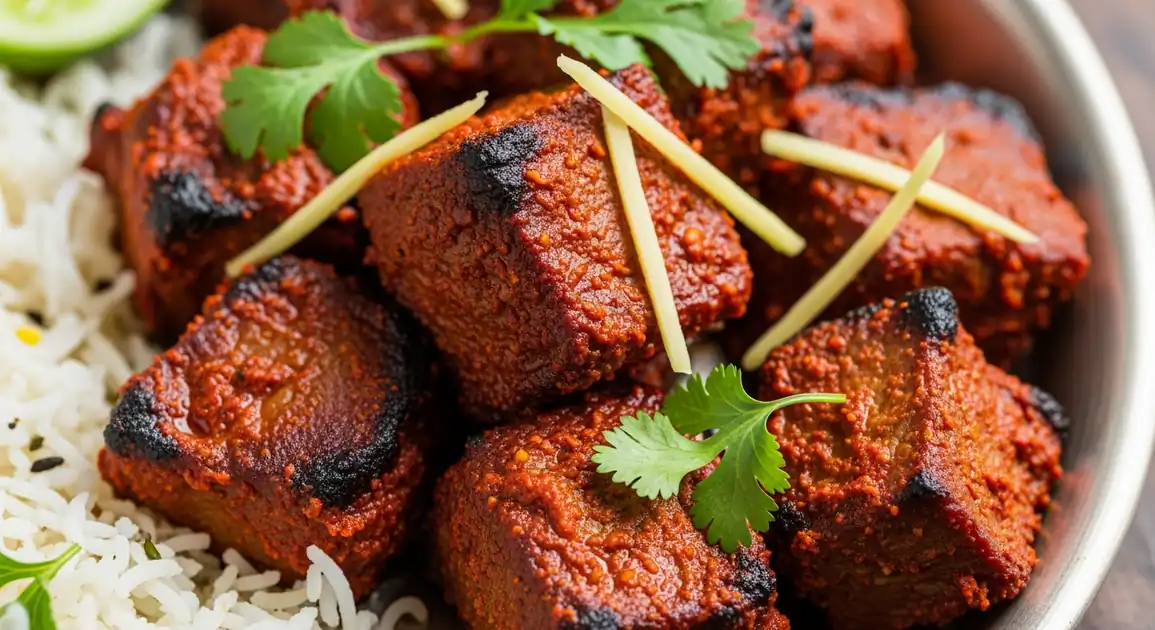Choila (Spicy Grilled Meat Salad)
छ्वेला

Description
Choila is a signature dish of the Newari people, concentrated in the Kathmandu Valley. While available across Nepal where Newari communities reside or in restaurants serving ethnic cuisine, the most authentic and varied Choila experiences are found within the Valley (Kathmandu, Lalitpur/Patan, Bhaktapur).
Dietary Information
Serving information
Serving style
Served warm or at room temperature on a plate, often metal or traditional leaf plate ('tapari'). Almost always accompanied by a side of 'chiura' (beaten rice). It's a key part of the 'Samay Baji' set.
Quick facts
Mainly afternoon (from 2 PM/3 PM onwards) and evening (until 9 PM/10 PM) in Khaja Ghars and restaurants.
Safety Tips
What to Look For
-
Meat prepared or mixed freshly upon order
Minimizes time the room-temperature dish sits around, ensuring freshness and reducing risk. Look for grilling action or mixing bowls in use.
-
Busy establishment with high turnover
Indicates ingredients are likely fresh and the Choila hasn't been sitting for too long. Popular with locals is a good sign.
-
Clean preparation area and utensils
Observe the general hygiene of the vendor or kitchen space.
-
Pungent, fresh mustard oil aroma (not stale or rancid)
Good quality, fresh mustard oil is key to the flavor and has some antimicrobial properties. A rancid smell is a bad sign.
-
Meat appears thoroughly cooked (before marinating)
Whether grilled or boiled, the initial cooking step must be thorough.
What to avoid
-
Large batches of Choila sitting uncovered at room temperature for long durations
Increases the risk of bacterial growth, especially in warm weather.
-
Meat that looks dry, discolored, or old
Suggests it's not fresh.
-
Places with obviously poor hygiene or cross-contamination practices
Avoid vendors handling money and food without washing hands, using dirty cloths, etc.
-
Stale or rancid oil smell
Indicates poor quality ingredients that affect taste and potentially safety.
Price information
Price range
Budget tips
- Local 'Khaja Ghars' offer the most affordable prices.
- Restaurants in tourist areas will generally charge more.
- Portion sizes can vary, confirm if ordering as a snack or part of a larger meal.
Value indicators
- Freshly prepared taste and aroma.
- Good balance of spice and pungent mustard oil.
- Tender (if Mana) or nicely charred (if Haku) meat.
- Served with fresh 'chiura' (beaten rice).
Where to Find This Dish
Newari Settlements
Areas with strong Newari populations within Kathmandu Valley (e.g., Kirtipur, Bungamati) and outside.
Traditional town centers
Afternoon, Evening
Tourist Hubs (Thamel, Pokhara Lakeside)
Restaurants specializing in Nepali/Newari cuisine cater to tourists.
Main tourist streets
Lunch, Dinner
Vendor Tips
- Ask locals for recommendations on the best 'Khaja Ghar' nearby.
- Specify meat preference if you don't want buff (e.g., 'Chicken choila chha?').
- Observe preparation if possible to gauge freshness.
How to Order
Regional Variations
-
Haku Choila
(हाकु छ्वेला)
Smoked/Grilled Choila. Meat is cooked over fire, giving it a distinct smoky flavor and charred bits.
-
Mana Choila
(मन छ्वेला)
Boiled/Steamed Choila. Meat is boiled or steamed before being marinated, resulting in a softer texture and no smokiness.
-
Chicken Choila
(कुखुराको छ्वेला)
Choila made with chicken meat instead of buffalo.
-
Duck Choila
(हाँसको छ्वेला)
Choila made with duck meat, richer and fattier than chicken.
-
Mutton Choila
(खसीको छ्वेला)
Choila made with goat meat (mutton).
-
Pork Choila
(सुँगुरको छ्वेला)
Choila made with pork, less common traditionally but available in some places.
Cultural context
History
Deeply embedded in Newari culture of the Kathmandu Valley, Choila is an indispensable part of feasts ('bhoj'), religious ceremonies, and festivals. It's a key component of the auspicious 'Samay Baji' ritual food set, symbolizing prosperity and tradition. Originally made with buffalo meat due to cultural practices, variations evolved over time. Its preparation and consumption are tied to community gatherings and celebrations.
Local significance
A culturally significant dish for the Newari community, integral to their feasts, rituals (like Samay Baji), and social gatherings.
Eating customs
- Eaten with hands, mixing bites of choila with chiura.
- Consumed as a snack ('khaja') or appetizer.
- Often paired with local alcoholic beverages like 'Aila' (spirit) or 'Thwon' (rice beer).